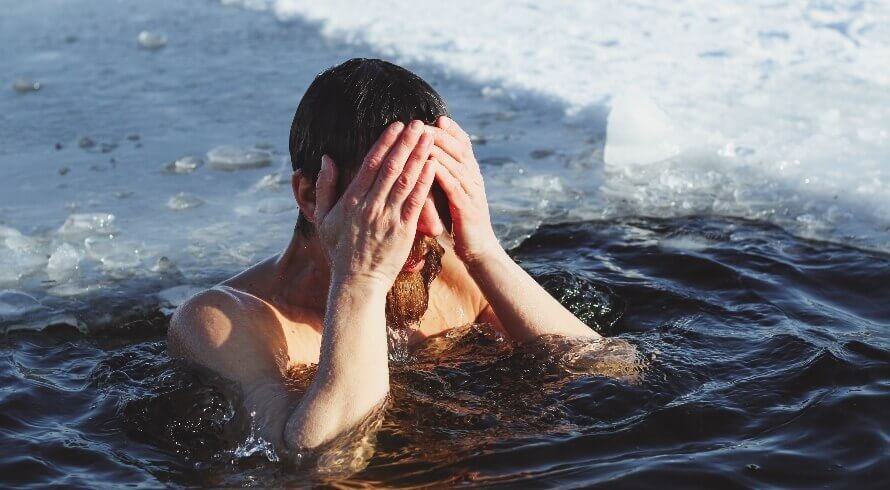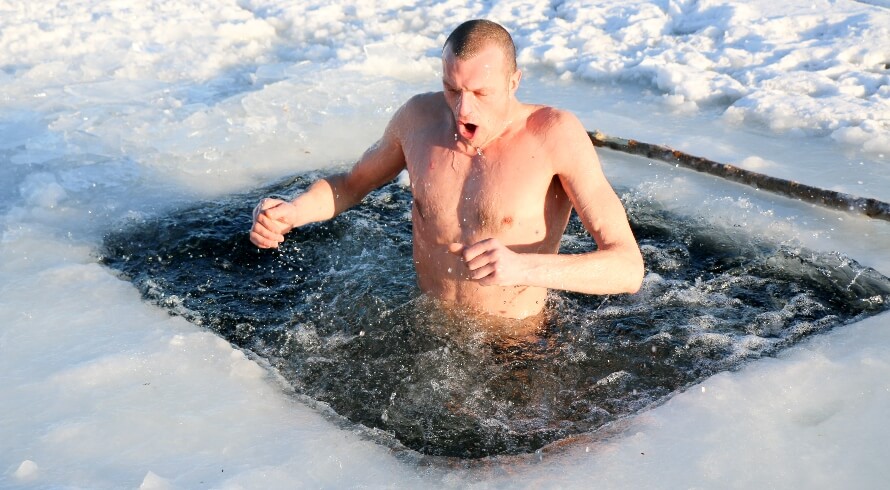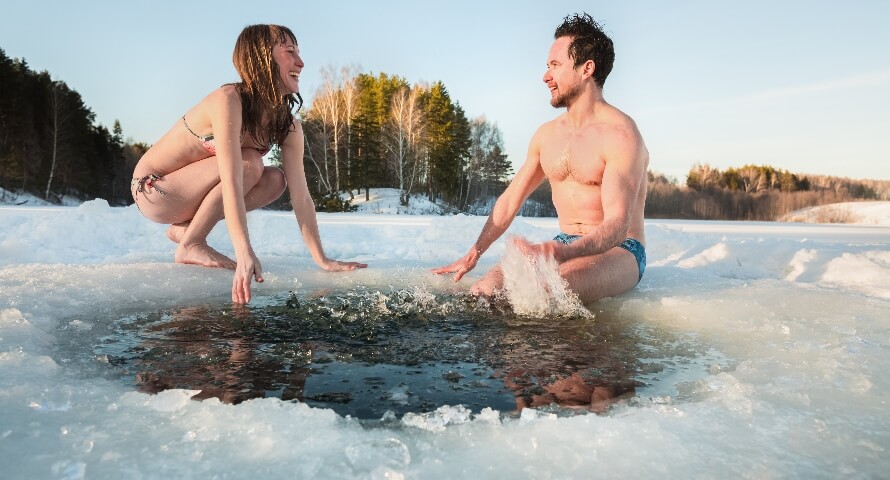According to most health, fitness, and biohacking “gurus,” taking an ice bath before or after a workout is the secret to faster recovery, sharper focus, and better performance.
Heck, even some scientists-cum-podcasters say so, too.
While this makes for a compelling spiel, scientific evidence doesn’t necessarily agree.
In fact, most research suggests using a cold plunge before or after a workout can actually make it harder to build muscle and gain strength.
In this article, you’ll find out why this is, discover the best time to cold plunge to avoid these issues, and more.
Key Takeaways
- Cold plunging, or “cold water immersion,” is the practice of immersing yourself up to your shoulders in cold water for a short period.
- Recently, it has become popular to cold plunge before or after a workout because some believe it sharpens focus, boosts testosterone and energy production, and accelerates recovery.
- Most research suggests taking a cold plunge before or after a workout can hurt your ability to build muscle and gain strength.
- Cold plunging before a workout might make you feel more alert, but it can lower muscle temperature, reduce strength, and hinder performance.
- An ice bath after a workout may reduce soreness, but it can also interfere with the muscle growth needed for building size and strength.
- The best time to cold plunge isn’t before or after a workout—do it on rest days to avoid disrupting your progress.
Table of Contents
+
What Is a Cold Plunge?

Cold plunging, or “cold water immersion,” is the practice of immersing yourself up to your shoulders in cold water for a short period. People have practiced cold plunging for centuries, using it as a way to recover from intense physical activity, reduce fatigue, and alleviate muscle soreness.
Cold plunging has recently surged in popularity, with health and fitness thought leaders endorsing it as a way to enhance mental clarity, accelerate recovery, and boost overall wellness.
Should You Cold Plunge Before a Workout?
Is jumping into a cold plunge pre-workout a smart move?
Here’s what science says about the pros and cons of cold plunging before your workout.
Benefits of Cold Plunging Before a Workout
The shock of entering cold water triggers the release of neurotransmitters such as serotonin, cortisol, dopamine, norepinephrine, and beta-endorphin, which can boost alertness and sharpen focus.
Advocates of taking a cold plunge pre-workout argue this can help you stay dialed in during training and push through challenging workouts with more intensity.
Several studies also show that “pre-cooling” (taking an ice bath or cold shower before a workout) may make endurance exercise in the heat feel less fatiguing and, thus, more manageable.
While interesting, there’s no evidence you get the same benefits of cold plunging before a workout involving resistance training, especially in an air-conditioned gym.
Another common claimed benefit of taking a cold plunge before a workout is that it boosts testosterone. Although these claims aren’t entirely baseless—some research suggests extreme cold exposure may increase “T” to some degree—the evidence isn’t very convincing.
Take, for example, a study conducted by the University of Canberra that many cite as “proof” cold plunging before exercise boosts testosterone.
The study had rugby players use cryotherapy before training, and while some showed an increase in T, the findings were flimsy at best.
First, it included only 12 men, and not all of them saw an increase. Second, it used cryotherapy at -220°F, which is much colder than a typical cold plunge at 60°F. Third, it measured testosterone levels at different times of the day for different participants without accounting for natural daily fluctuations.
Finally, it only tracked testosterone levels for three hours after the workout. While some men did see a short-term spike, this kind of brief increase is unlikely to have any meaningful long-term effect on muscle growth.
Testosterone isn’t the only buzzword thrown around when it comes to cold plunging. The promise of increased “mitochondrial density” is another popular selling point.
The pro-cold-plunge crowd argue that pre-workout cold exposure boosts the number of mitochondria in brown fat and muscle cells, which could enhance your body’s ability to produce energy and, therefore, boost athletic performance.
While this theory sounds intriguing, current evidence only comes from studies on rodents. Until human studies back these claims, it’s sensible to stay skeptical.
Drawbacks of Cold Plunging Before a Workout
Cold plunging before a workout has clear downsides.
First, research shows that as muscle temperature drops, so does its ability to generate force.
One study found that a decrease of just 1.8°F in muscle temperature caused a 4.2% decline in power, while another study found that cooling muscles to 84°F reduced peak force production by up to 21%.
The takeaway: cold muscles simply don’t perform as well as warm ones, so if your workout involves heavy lifting or explosive movements, taking a cold plunge before your workout could hurt your performance.
Cold exposure also slows nerve conduction (how electrical signals travel along nerves), which can affect coordination, reaction times, manual dexterity, and movement efficiency. In other words, taking an ice bath before your workout could make performing complex exercises like squats, deadlifts, presses, and pull-ups more challenging.
And when exercises are difficult to perform, you’ll lift less weight for fewer reps, which will hamper your ability to gain muscle and strength over time.
Then there’s the impact on balance. Cold exposure can hinder balance whether you’re standing still or moving in multiple directions. Thus, taking a cold plunge before your workout might make it harder to stabilize your body during exercises that require balance and coordination like Bulgarian split squats or lunges.
Should You Cold Plunge After a Workout?

Many think the best time to cold plunge is after you’ve worked out. The theory goes that doing so promotes rapid recovery and reduces soreness.
Is this true?
Here are the pros and cons of taking a cold plunge after a workout.
Benefits of Cold Plunging After a Workout
Research shows that cold plunging after a workout can reduce delayed onset muscle soreness (DOMS), lower blood markers of muscle damage and inflammation, reduce swelling, help clear waste products from your muscles, and make you feel less tired.
For these reasons, it can be good for recovery.
The only caveat is that while cold plunging after your workout can make you feel better, it doesn’t always translate to better performance.
In other words, it may soothe your sore muscles, but it won’t necessarily help you recover your strength faster. And if a recovery modality doesn’t allow you to train harder sooner, it’s probably not a great use of time.
That doesn’t mean you shouldn’t give cold plunging a shot—it may be worth trying to see how it affects your recovery. But focus less on how it makes you feel and more on whether it helps you recoup your strength faster.
If it makes you feel better and helps you regain your strength more quickly, keep it in your routine. But if it only reduces soreness without improving your performance, you might get more benefit from other recovery modalities (like supplementing intelligently or sleeping more).
Drawbacks of Cold Plunging After a Workout
If your main goal is to build muscle, taking a cold plunge after your workouts may not be the best idea.
A 2019 study conducted by Deakin University found that people who took an ice bath after their workouts gained less muscle than those who didn’t. Two other studies found similar results.
Why does cold water immersion reduce muscle growth?
Scientists believe it disrupts the molecular pathways—chains of chemical reactions in the body—that drive muscle growth. For instance, ice baths lower the blood levels of proteins that help build muscle and increase the levels of proteins that break it down.
Cold plunging also cools your muscles, which hinders the enzymes that repair and grow muscle and reduces blood flow—both of which are crucial for muscle growth.
When Is the Best Time to Cold Plunge?

If your goal is to build muscle and gain strength, don’t cold plunge before or after your workouts.
Cold plunging before lifting weights might make you feel more alert, but it will likely hinder your performance, making it harder to gain size and strength.
Cold plunging after strength training can also directly limit muscle growth, so it’s not a smart move either.
The best time to cold plunge is on rest days, ideally as far from your last workout as possible. For example, if you train on Monday morning, wait until Tuesday evening or Wednesday to take an ice bath.
This reduces the chance that your cold plunge will disrupt the bodily processes involved in muscle growth.
FAQ #1: How long should you cold plunge before a workout?
Generally speaking, using a cold plunge before a workout isn’t a good idea, especially if your goal is to build muscle or gain strength. Cold exposure reduces the temperature of your muscles, decreases how much force you can produce, and hinders coordination, all of which can hamper performance.
If you want to cold plunge pre-workout to help with endurance in the heat, research suggests 2-to-4 minutes is long enough to get benefits without experiencing drawbacks.
FAQ #2: What are the benefits of cold plunging?
Cold plunging can provide several benefits, depending on when and how you use it.
If you cold plunge before a workout, it may increase alertness and focus by triggering a release of neurotransmitters like dopamine and norepinephrine. It can also help with endurance exercise in hot conditions by lowering your core body temperature, making the heat feel less fatiguing.
If you cold plunge after a workout, it can reduce DOMS, lower inflammation, reduce swelling, and help clear waste products from your muscles. These effects can make you feel less tired and more recovered.
However, if your main goal is to build muscle or gain strength, cold plunging before or after a workout may not be ideal, as it can hinder performance and muscle growth.
FAQ #3: How long should I cold plunge for the benefits?
If you cold plunge after a workout to reduce DOMS, research suggests bathing in 52-to-59-degree water for 11-to-15 minutes is optimal.
If you cold plunge before an endurance workout in the heat, bathe for around 2-to-4 minutes.
Scientific References +
- Allan, Robert, et al. “Cold for Centuries: A Brief History of Cryotherapies to Improve Health, Injury and Post-Exercise Recovery.” European Journal of Applied Physiology, vol. 122, no. 5, 23 Feb. 2022, link.springer.com/article/10.1007/s00421-022-04915-5, https://doi.org/10.1007/s00421-022-04915-5.
- Kelly, John S., and Ellis Bird. “Improved Mood Following a Single Immersion in Cold Water.” Lifestyle Medicine, vol. 3, no. 1, 2 Dec. 2021, onlinelibrary.wiley.com/doi/full/10.1002/lim2.53, https://doi.org/10.1002/lim2.53.
- Yankouskaya, Ala, et al. “Short-Term Head-out Whole-Body Cold-Water Immersion Facilitates Positive Affect and Increases Interaction between Large-Scale Brain Networks.” Biology, vol. 12, no. 2, 29 Jan. 2023, p. 211, https://doi.org/10.3390/biology12020211.
- Choo, Hui C., et al. “Ergogenic Effects of Precooling with Cold Water Immersion and Ice Ingestion: A Meta-Analysis.” European Journal of Sport Science, vol. 18, no. 2, 26 Nov. 2017, pp. 170–181, https://doi.org/10.1080/17461391.2017.1405077. Accessed 28 Jan. 2020.
- Bongers, Coen C. W. G., et al. “Cooling Interventions for Athletes: An Overview of Effectiveness, Physiological Mechanisms, and Practical Considerations.” Temperature, vol. 4, no. 1, 3 Jan. 2017, pp. 60–78, www.ncbi.nlm.nih.gov/pmc/articles/PMC5356217/, https://doi.org/10.1080/23328940.2016.1277003.
- Russell, M., et al. “The Effects of a Single Whole Body Cryotherapy Exposure on Physiological, Performance and Perceptual Responses of Professional Academy Soccer Players Following Repeated Sprint Exercise.” Journal of Strength and Conditioning Research, vol. 31, no. 2, May 2016, p. 1, https://doi.org/10.1519/jsc.0000000000001505.
- M. Partridge, Emily, et al. “Application of Acute Pre-Exercise Partial-Body Cryotherapy Promotes Jump Performance, Salivary-Amylase and Athlete Readiness.” Biology of Sport, 2022, https://doi.org/10.5114/biolsport.2022.107019. Accessed 28 Oct. 2021.
- Qiu, Jiamin, et al. “FAM210A Is Essential for Cold-Induced Mitochondrial Remodeling in Brown Adipocytes.” Nature Communications, vol. 14, no. 1, 10 Oct. 2023, https://doi.org/10.1038/s41467-023-41988-y. Accessed 7 Apr. 2024.
- Chung, Nana, et al. “The Effects of Exercise and Cold Exposure on Mitochondrial Biogenesis in Skeletal Muscle and White Adipose Tissue.” Journal of Exercise Nutrition & Biochemistry, vol. 21, no. 2, 30 June 2017, pp. 39–47, www.ncbi.nlm.nih.gov/pmc/articles/PMC5545200/, https://doi.org/10.20463/jenb.2017.0020. Accessed 8 Feb. 2023.
- Davies, C. T., and K. Young. “Effect of Temperature on the Contractile Properties and Muscle Power of Triceps Surae in Humans.” Journal of Applied Physiology, vol. 55, no. 1, 1 July 1983, pp. 191–195, https://doi.org/10.1152/jappl.1983.55.1.191. Accessed 13 Oct. 2020.
- Cross, Kevin M., et al. “Functional Performance Following an Ice Immersion to the Lower Extremity.” Journal of Athletic Training, vol. 31, no. 2, 1996, pp. 113–116, www.ncbi.nlm.nih.gov/pmc/articles/PMC1318440/.
- Fischer, Jennifer, et al. “Functional Performance Following an Ice Bag Application to the Hamstrings.” Journal of Strength and Conditioning Research, vol. 23, no. 1, Jan. 2009, pp. 44–50, https://doi.org/10.1519/jsc.0b013e3181839e97. Accessed 27 Aug. 2019.
- Didehdar, Daryoush, and Sobhan Sobhani. “The Effect of Cold-Water Immersion on Physical Performance.” Journal of Bodywork and Movement Therapies, vol. 23, no. 2, Apr. 2019, pp. 258–261, https://doi.org/10.1016/j.jbmt.2018.05.001.
- Bergh, U, and B Ekblom. “Influence of Muscle Temperature on Maximal Muscle Strength and Power Output in Human Skeletal Muscles.” Acta Physiologica Scandinavica, vol. 107, no. 1, 1979, pp. 33–7, www.ncbi.nlm.nih.gov/pubmed/525366, https://doi.org/10.1111/j.1748-1716.1979.tb06439.x.
- Sargeant, Anthony J. “Effect of Muscle Temperature on Leg Extension Force and Short-Term Power Output in Humans.” European Journal of Applied Physiology and Occupational Physiology, vol. 56, no. 6, Sept. 1987, pp. 693–698, https://doi.org/10.1007/bf00424812.
- Herrera, Esperanza, et al. “Motor and Sensory Nerve Conduction Are Affected Differently by Ice Pack, Ice Massage, and Cold Water Immersion.” Physical Therapy, vol. 90, no. 4, 1 Apr. 2010, pp. 581–591, https://doi.org/10.2522/ptj.20090131.
- Cheung, Stephen S., et al. “Changes in Manual Dexterity Following Short-Term Hand and Forearm Immersion in 10 Degrees c Water.” Aviation, Space, and Environmental Medicine, vol. 74, no. 9, 1 Sept. 2003, pp. 990–993, pubmed.ncbi.nlm.nih.gov/14503680/. Accessed 11 Sept. 2022.
- Mäkinen TM;Rintamäki H;Korpelainen JT;Kampman V;Pääkkönen T;Oksa J;Palinkas LA;Leppäluoto J;Hassi J. “Postural Sway during Single and Repeated Cold Exposures.” Aviation, Space, and Environmental Medicine, vol. 76, no. 10, 2024, pubmed.ncbi.nlm.nih.gov/16235878/. Accessed 16 Sept. 2024.
- MONTGOMERY, ROGER E., et al. “Effect of Segmental, Localized Lower Limb Cooling on Dynamic Balance.” Medicine & Science in Sports & Exercise, vol. 47, no. 1, Jan. 2015, pp. 66–73, https://doi.org/10.1249/mss.0000000000000379. Accessed 7 Jan. 2020.
- Dupuy, Olivier , et al. An Evidence-Based Approach for Choosing Post-Exercise Recovery Techniques to Reduce Markers of Muscle Damage, Soreness, Fatigue, and Inflammation: A Systematic Review with Meta-Analysis. 28 Apr. 2018, https://doi.org/10.3389/fphys.2018.00403.
- Angelopoulos, Pavlos, et al. “Cold-Water Immersion and Sports Massage Can Improve Pain Sensation but Not Functionality in Athletes with Delayed Onset Muscle Soreness.” Healthcare, vol. 10, no. 12, 5 Dec. 2022, p. 2449, https://doi.org/10.3390/healthcare10122449. Accessed 10 Dec. 2022.
- Fyfe, Jackson J., et al. “Cold Water Immersion Attenuates Anabolic Signaling and Skeletal Muscle Fiber Hypertrophy, but Not Strength Gain, Following Whole-Body Resistance Training.” Journal of Applied Physiology, vol. 127, no. 5, 1 Nov. 2019, pp. 1403–1418, https://doi.org/10.1152/japplphysiol.00127.2019.
- Roberts, Llion A., et al. “Post-Exercise Cold Water Immersion Attenuates Acute Anabolic Signalling and Long-Term Adaptations in Muscle to Strength Training.” The Journal of Physiology, vol. 593, no. 18, 13 Aug. 2015, pp. 4285–4301, https://doi.org/10.1113/jp270570.
- Yamane, M., et al. “Does Regular Post-Exercise Cold Application Attenuate Trained Muscle Adaptation?” International Journal of Sports Medicine, vol. 36, no. 08, 11 Mar. 2015, pp. 647–653, https://doi.org/10.1055/s-0034-1398652. Accessed 12 Sept. 2019.










